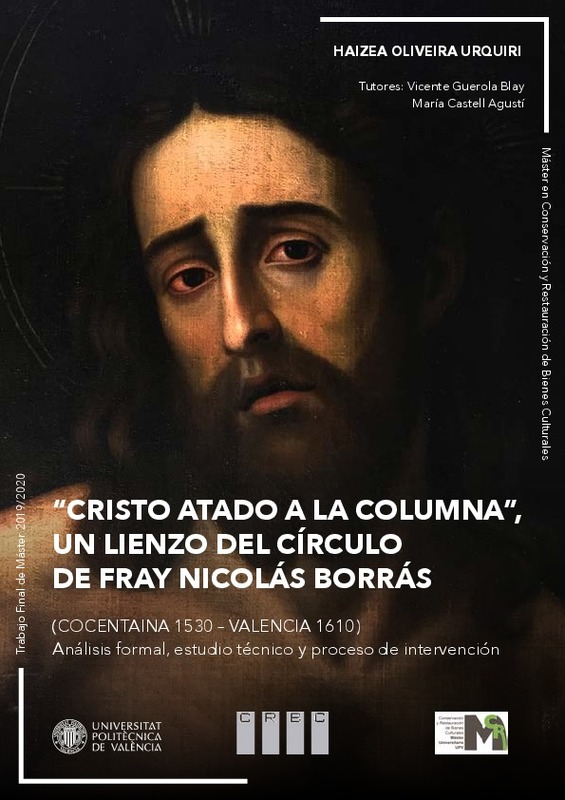|
Resumen:
|
[ES] El presente Trabajo Final de Master tiene como objeto de estudio e investigación una pintura sobre lienzo, conservada en la Parroquia de San Nicolás de Valencia, concretamente en el espacio de la antigua sacristía. ...[+]
[ES] El presente Trabajo Final de Master tiene como objeto de estudio e investigación una pintura sobre lienzo, conservada en la Parroquia de San Nicolás de Valencia, concretamente en el espacio de la antigua sacristía. La obra representa el pasaje evangélico donde Jesús se encuentra atado a la columna después de ser sometido a la flagelación, en un entorno arquitectónico vacío. La pintura es deudora de los postulados de la Contrarreforma, el encuadre presenta la figura a escala del natural de forma recogida mirando al espectador según los cánones de la pintura de finales del siglo XVI, que pretende suscitar sentimientos de contrición y arrepentimiento. Las fuentes gráficas del cuadro cabe rastrearlas en la producción pictórica del pintor valenciano manierista Juan de Juanes (1510-1579), al cual se debe la invención de la composición primigenia. Descartando de antemano la adscripción de la obra al maestro por los condicionantes estéticos y formales. Se ha llevado a término una revisión de la producción pictórica de sus inmediatos seguidores, planteando como hipótesis de partida la atribución de la obra a uno de sus más destacados colaboradores, el pintor Fray Nicolás Borrás (1530-1610). El estudio técnico permitió documentar algunas restauraciones realizadas anteriormente, algunas de las cuales derivaron en una pérdida de las veladuras, cuestión que puntualmente produjo una abrasión en las equimosis repartidas en el cuerpo lacerado de Cristo. La pintura presentaba una pérdida de resistencia mecánica y potencial estético, causados por los numerosos rasgados presentes en el tejido y la acumulación de suciedad sobre la película pictórica. Los procesos de restauración se han llevado a término en el taller-laboratorio de pintura de caballete y retablos del Instituto de Restauración del Patrimonio de la Universidad Politécnica de Valencia. Los resultados obtenidos en la presente investigación han sido dados a conocer en diferentes medios de comunicación, tanto en prensa, como en televisión y finalmente, en un artículo de divulgación. Estos parámetros de difusión deben considerarse como un objetivo de puesta en valor de la obra.
[-]
[EN] The following Master's final Project has as the subject matter the study and research of a painting on canvas, conservated in the Parish of St. Nicholas of Valencia, specifically in the space of the old sacristy. The ...[+]
[EN] The following Master's final Project has as the subject matter the study and research of a painting on canvas, conservated in the Parish of St. Nicholas of Valencia, specifically in the space of the old sacristy. The work represents the Gospel passage where Jesus is tied to the column after being subjected to the flogging, in an empty architectural setting. The painting is debtor to the postulates of the Counter-Reformation, the framing presents the figure at life-size in a collected way looking at the viewer according to the canons of late sixteenth-century painting, which seeks to arouse feelings of contrition and regret. The graphic sources of the painting can be traced back to the pictorial production of the Valencian Mannerist painter Juan de Juanes (1510-1579), to whom we owe the invention of the original composition. Discarding beforehand the assignment of the work to the master because of the aesthetic and formal conditions. A revision of the pictorial production of his immediate followers has been carried out, proposing as a starting hypothesis the attribution of the work to one of his most outstanding collaborators, the painter Fray Nicolás Borrás (1530-1610). The technical study made it possible to document some restorations previously executed, some of which resulted in a loss of the glazes, which caused abrasion to the ecchymosis distributed on the lacerated body of Christ. The Paint shows a loss of mechanical resistance and aesthetic potential, caused by the numerous tears spotted in the fabric and the accumulation of dirt on the paint film. The restoration processes have been conducted in the workshop-laboratory for easel and altarpiece painting of the Institute for the Heritage Restoration of the Polytechnic University of Valencia. The results obtained in this research have been published in different media, both in the press and on television, and finally, in an article. These dissemination parameters must be considered as an aim for the enhancement of the work.
[-]
|







